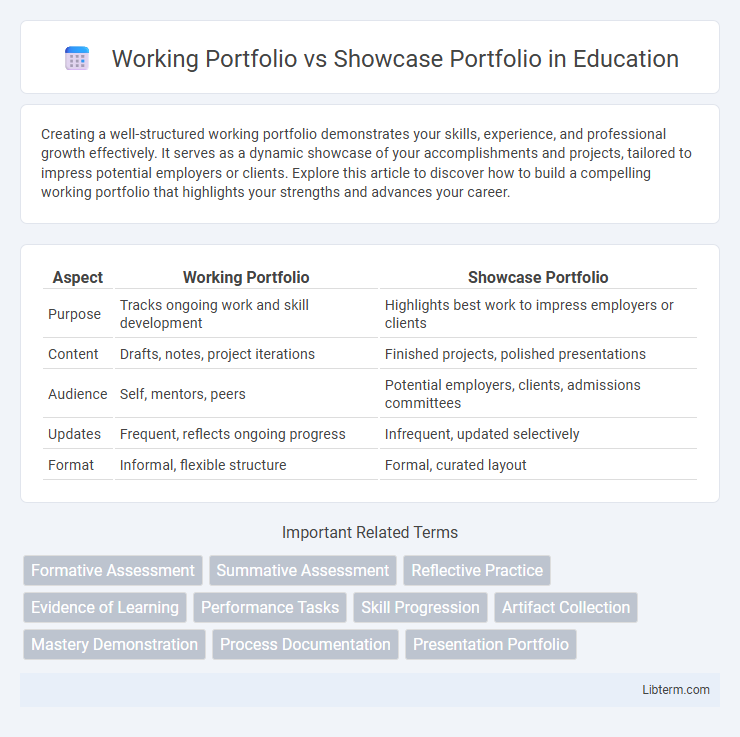Creating a well-structured working portfolio demonstrates your skills, experience, and professional growth effectively. It serves as a dynamic showcase of your accomplishments and projects, tailored to impress potential employers or clients. Explore this article to discover how to build a compelling working portfolio that highlights your strengths and advances your career.
Table of Comparison
| Aspect | Working Portfolio | Showcase Portfolio |
|---|---|---|
| Purpose | Tracks ongoing work and skill development | Highlights best work to impress employers or clients |
| Content | Drafts, notes, project iterations | Finished projects, polished presentations |
| Audience | Self, mentors, peers | Potential employers, clients, admissions committees |
| Updates | Frequent, reflects ongoing progress | Infrequent, updated selectively |
| Format | Informal, flexible structure | Formal, curated layout |
Understanding Working Portfolios
Working portfolios serve as dynamic collections of ongoing projects, capturing the iterative process, development stages, and skill refinement over time, offering a comprehensive view of an individual's growth and adaptability. These portfolios emphasize transparency in methods, challenges faced, and problem-solving strategies, contrasting with showcase portfolios that highlight polished, final products. Employers and educators value working portfolios for their authenticity and ability to demonstrate real-time learning and creative evolution.
Defining Showcase Portfolios
Showcase portfolios highlight an individual's best work, emphasizing quality and impact to attract potential employers or clients. They often include carefully selected projects that demonstrate specific skills, creativity, and professional achievements. Unlike working portfolios, which serve as ongoing collections for personal use and development, showcase portfolios are curated to present a polished, market-ready narrative of expertise.
Key Differences Between Working and Showcase Portfolios
Working portfolios document a comprehensive collection of ongoing projects, drafts, and process work, emphasizing development and iterative improvements. Showcase portfolios highlight a curated selection of polished, finalized work intended to demonstrate skills and achievements to potential clients or employers. The key difference lies in the purpose: working portfolios serve as a developmental tool for reflection and growth, while showcase portfolios function as marketing tools for career advancement.
Purpose and Goals of Each Portfolio Type
A Working Portfolio is designed to document ongoing progress and development, serving as a reflective tool for both the creator and evaluators by highlighting strengths, weaknesses, and learning milestones. In contrast, a Showcase Portfolio aims to present the best and most polished work to impress potential employers, clients, or academic committees, focusing on quality and target-specific achievements. While the Working Portfolio emphasizes growth and process, the Showcase Portfolio targets demonstration of expertise and readiness for professional opportunities.
Content Selection for Working vs Showcase Portfolios
Content selection for a working portfolio emphasizes breadth and ongoing development, featuring drafts, experiments, and process documentation to demonstrate growth and problem-solving skills. Showcase portfolios prioritize polished, high-impact projects that highlight mastery and key achievements, ensuring each piece aligns with professional goals and audience expectations. Choosing content strategically in each type enhances the portfolio's purpose: working portfolios for collaboration and feedback, showcasing portfolios for presentation and career advancement.
Target Audiences for Each Portfolio
Working portfolios cater primarily to recruiters and hiring managers seeking comprehensive evidence of an individual's skills and project progression, emphasizing detailed case studies and iterative work. Showcase portfolios target potential clients and collaborators by highlighting polished, finalized projects that demonstrate creative excellence and tangible results. Understanding these distinct target audiences ensures portfolio content aligns with the goal of either proving technical competence or attracting business opportunities.
Benefits of Maintaining a Working Portfolio
Maintaining a working portfolio offers ongoing documentation of skills development and project progress, providing a dynamic record for employers and clients. It enables real-time reflection and iterative improvement, showcasing adaptability and continuous learning. This portfolio type highlights diverse competencies and problem-solving capabilities across various stages of work, enhancing professional credibility.
Advantages of Creating a Showcase Portfolio
Creating a showcase portfolio offers the advantage of highlighting your best work, making it easier for potential employers or clients to quickly assess your skills and style. This type of portfolio allows for a curated selection that demonstrates expertise and achievements, enhancing your professional brand and marketability. By focusing on quality over quantity, a showcase portfolio effectively captures attention and leaves a strong, memorable impression.
When to Use Each Portfolio Type
A working portfolio is ideal for ongoing projects, professional development, and continuous skill refinement, allowing for regular updates and reflections on progress. Showcase portfolios best suit job applications, client presentations, or formal evaluations by highlighting polished, finalized work that demonstrates expertise and achievements. Choosing the right portfolio depends on whether the goal is to document growth or impress with completed, high-quality examples.
Tips for Transitioning from Working to Showcase Portfolio
When transitioning from a working portfolio to a showcase portfolio, prioritize selecting only the most impactful and completed projects that demonstrate your skills and achievements. Highlight results, metrics, and client feedback to emphasize your professional growth and value. Organize your portfolio thematically or by expertise to create a clear, compelling narrative that resonates with your target audience.
Working Portfolio Infographic

 libterm.com
libterm.com